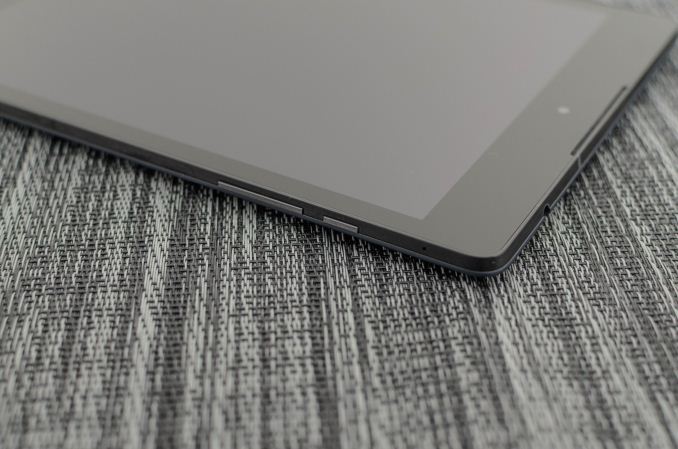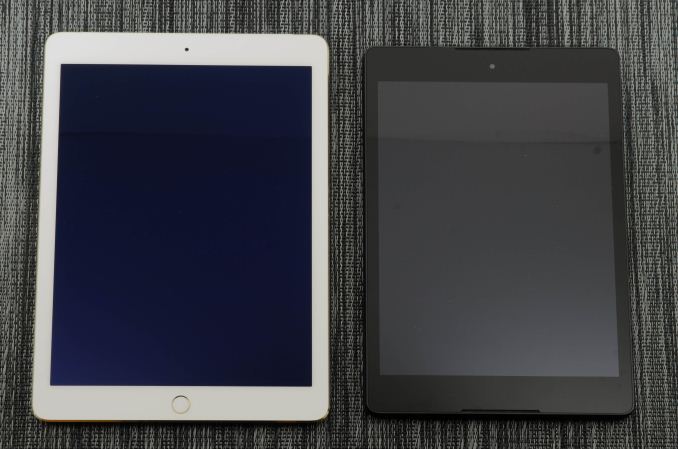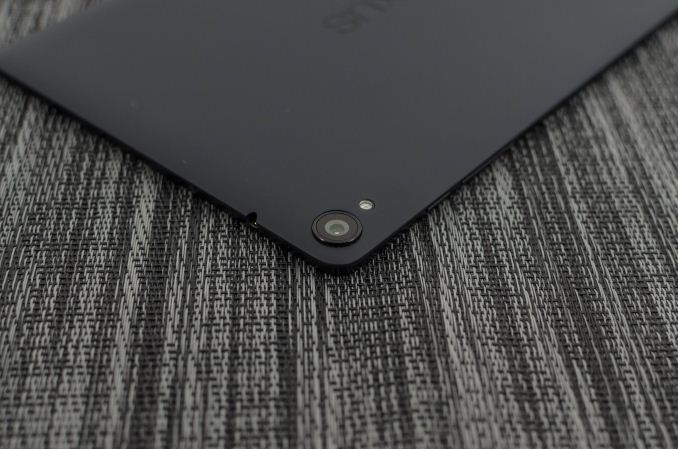The Google Nexus 9 Review
by Joshua Ho & Ryan Smith on February 4, 2015 8:00 AM EST- Posted in
- Tablets
- HTC
- Project Denver
- Android
- Mobile
- NVIDIA
- Nexus 9
- Lollipop
- Android 5.0
Final Words
The Nexus 9 is undoubtedly an aspirational device. For a long time now, Google and the Android tablet market in general have been in a position similar to Amazon’s Fire tablet. This has meant that the margin on the hardware itself has been quite low, and while quality was possible to achieve there were often sacrifices made in order to reach the targeted price point. This was seen in the form of lower CPU and GPU bins in the SoC, lower quality NAND, and generally poorer displays.
The Nexus 7 (2013) did manage to mostly avoid these issues, but Google had set the bar for price and performance to the point where OEMs would have issues with maintaining acceptable profit margins on a device. The Nexus 9 changes this strategy by reaching for a higher price point and attempting to deliver a no-compromise tablet in return. To figure out whether Google has succeeded, it’s worth going over each aspect of the device before coming to any sort of judgment.
The first and quite possibly most important aspect of the Nexus 9 is the SoC. To this end, the Nexus 9 is the very first Android device with AArch64 support enabled in Android. NVIDIA’s Tegra K1 with Denver is effectively the state of the art when it comes to SoCs in the Android OEM space, and no other device has launched with this SoC. While the fact that the SoC is built around the ARMv8 ISA is important, the architecture of the CPU itself is easily one of the most interesting designs we’ve seen in years. Unfortunately, while the design of the CPU is academically interesting it doesn’t seem that this produces real-world benefits. The Nexus 9 has one of the fastest SoCs we’ve seen to date, but this comes at the cost of worse power efficiency than the Cortex A15 version of the Tegra K1.
Another piece of the puzzle is the design, which is one of the key differentiators for a high-end mobile device. While one can debate the merits of various materials, it seems to be clear that an all-metal unibody chassis would’ve greatly improved the design of the Nexus 9 and justified its positioning better. While there is some level of give in the back cover, the buttons are quite thin and hard to find, and there’s a noticeable seam where the back cover and metal frame meet, the design isn’t actually all that bad in practice. Unfortunately, this seems to be a bit of a sore point as well for the Nexus 9 when compared against the iPad lineup.
While the SoC and design are often points of distinction for a premium tablet, the display is critical for any tablet. In this regard, the Nexus 9 does surprisingly well. With a 4:3 aspect ratio, high resolution, and high quality color calibration HTC and Google have outfitted the Nexus 9 with a great display. Unfortunately, there’s a great deal of variability present in these displays that presents itself in the form of backlight bleed along the edges of the display. While my unit only has a slight amount of bleed along the top edge of the device, other units can have more or less backlight bleed depending upon variance in production.
The one aspect that seems to be the product of a poor design choice is the high reflectivity of the display. Although I’m reasonably sure that the display is laminated due to the lack of an obvious gap between the display and glass, it seems that the optical material between the display and glass is poorly designed as I can see a distracting double reflection in the display. The Nexus 9 also compares unfavorably to the iPad Air 2 in this case as the anti-reflective coating on the iPad Air 2 is far superior to just about anything I’ve seen on the market.
Although I previously noted that the power efficiency of the SoC isn’t up to scratch, overall battery life is quite good on the Nexus 9. With a combination of a large battery and efficient display, Google and HTC have managed to compensate for the power consumption issues that come with Denver’s performance. Unfortunately, it seems that Kepler’s desktop-first design results in worse power efficiency than what we see on competing solutions such as the “GXA6850” found in competing SoCs. Even if this is compensated for by the ability to enable desktop-class gaming, the Nexus 9 doesn’t appear to support full OpenGL to begin with, unlike the SHIELD Tablet. This means that the extra capabilities enabled by the GPU are effectively wasted, which hurts the value proposition for the device overall. In light of the launch of the Tegra X1, I can't help but wonder how different the experience of the Nexus 9 would be with NVIDIA's latest SoC.
Outside of these primary elements of the tablet, there seems to be a reasonable level of attention to detail. The camera is acceptable, even if the focus and capture latency aren’t the greatest. The audio quality from the speakers is also quite good, and really helps to enable a great experience when watching any kind of video or listening to music without earbuds/headphones. The software experience is acceptable, although Google continues to fight issues with ecosystem support for tablets.
With all of this in mind, it’s hard to give a resounding recommendation of the Nexus 9. The Nexus 9 is a step towards a high-end Android tablet, but not the leap that Google was hoping for. If you want an Android tablet near the size of the Nexus 9, I can’t really recommend anything else. The Galaxy Tab S falls short on account of performance and battery life, and despite the somewhat unremarkable design of the Nexus 9 I believe that it is nicer than the Galaxy Tab S. However, if one were to assume that OEMs are currently readying devices to truly carry the torch of the high-end tablet, the Nexus 9 is a hard sell. I suspect that this wouldn’t be nearly as difficult if the Nexus 9 had a lower price point of $300 and $350 USD for the 16GB and 32 GB WiFi variants, and $450-$500 for the 32GB LTE variant. Google has managed to get close to the mark with the Nexus 9, but like the Nexus 6 it seems that it’s up to the OEMs to cover the remaining distance.














169 Comments
View All Comments
mkygod - Saturday, February 7, 2015 - link
I think so to. The 3:2 ratio is one of the things that Microsoft has gotten right with their Surface Pro devices. It's the perfect compromise IMOUtilityMax - Sunday, February 8, 2015 - link
I am a little perplexed by this comment. A typical user will be on the web 90% of time. Not only the web browser does not need to be natively designed or optimized for any screen ratio, but it also will be more usable on a 4:3 screen. So will the productivity apps. The only disappointment for me on the 4:3 screen would be with watching the widescreen videos or TV shows. Moreover, there is quite a bit of evidence than a lot of the next generation tablets will be 4:3. Samsung's next flagship tablet supposedly will be 4:3.gtrenchev - Wednesday, February 4, 2015 - link
Anandtech is becoming more and more boring last year. Sparse on reviews, short on tech comments, lacking on depth and enthusiasm. I can see Anandtech has become a just job for you guys, not the passion it was for Anand :-) And yes, his absence is definitely noticeable.George
Ian Cutress - Wednesday, February 4, 2015 - link
Was the Denver deep-dive not sufficient enough? Always welcome for comments.As for timing, see Ryan's comment above.
We've actually had a very good quarter content wise, with a full review on the front page at least four out of every five weekdays if not every weekday.
milkod2001 - Wednesday, February 4, 2015 - link
Why not to post on your forum some sort of suggestion box/poll where all could say what should get reviewed first so some folks won't cry where is the review of their favorite toy :) ?Impulses - Wednesday, February 4, 2015 - link
Because they'll still cry regardless, and they can't possibly work entirely based on readers' whim, doesn't make sense logistically or nor editorially... Readers might vote on five things ahead of the rest which all fall on the same writer's lap, they won't all get reviewed before the rest, or readers might not be privy to new hardware because of NDAs or cases where Anandtech can't source something for review.tuxRoller - Thursday, February 5, 2015 - link
While I enjoyed the review, I would've loved to have seen the kind of code driven analysis that was done with Swift.In particular, how long does it take for dco to kick in. What is the IPC for code that NEVER gets optimized, and conversely, what is the IPC for embarrassingly instruction-wise parallel code? Since it's relying on ram to store the uops, how long does the code need to run before it breaks even with the arm decoder? Etc.
victorson - Wednesday, February 4, 2015 - link
Are you guys kidding? Better late than never, but heck.. this is freaking late.abufrejoval - Wednesday, February 4, 2015 - link
Thanks for making it worth the wait!The in-depth analysis of Denver is uniquely Anandtech, because you can't get that anywhere else.
And while Charly D. is very entertaining, the paywall is a bit of an impediment and I quite like again the Anand touch of trying to be as fair as possible.
I was and remain a bit worried that there seems to be no other platform for Denver, which typically signals a deeper flaw with an SoC in the tablet and phone space.
While I'm somewhat less worried now, that Denver might be acceptable as a SoC, the current Nexus generation is no longer attractive at these prices, even less with the way the €/$ is evolving.
Taneli - Wednesday, February 4, 2015 - link
eDRAM cache à la Crystalwell would be interesting in a future Denver chip.